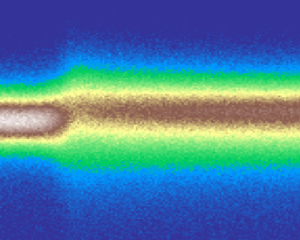
Optoelectronic applications root on excited electronic states. In semiconductors, there are two types of excited states: many-body states like bound electron-hole states, so-called excitons, and simpler quasi-particle states, typically referred to as quasi-free carriers (QFCs). In general, both types coexist in a dynamical interplay of exciton and QFC populations.
Using the free-electron laser Flash at Desy in Hamburg in conjunction with a time-of-fligh momentum microscope, we were able to track the time-dependent electronic structure of the layered semiconductor WSe2 on an ultrafast timescale. Our findings demonstrate a novel, at first glance counter-intuitive approach for accessing exciton and QFC dynamics on ultrafast time scales: the photoemission lineshapes of core levels, i.e. states deep below the frontier orbitals, turn out to be sensitive probes of the electron dynamics occurring in the valence and conduction band. By combining time-resolved photoemission spectroscopy simultaneously probing excited states and core levels with a novel lineshape model, we retrieved how the character of excited states changes from excitonic to QFC-like, across the excitonic Mott transition.